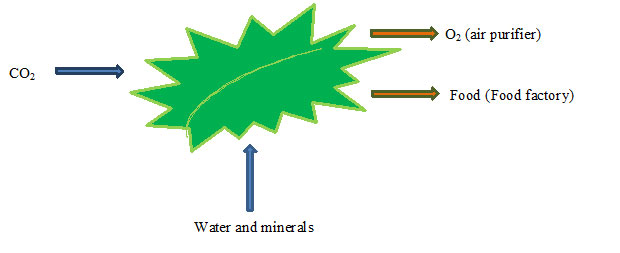Origin of renewable energy sources – Biomass

1.8 Biomass
Biomass, as the name implies, refers to biological or organic materials. Simply, biomass represents either living or dead, animal and plant materials.
Wood chips, tree branches, biodiesel, landfill gas, ethanol, coconut shells, and sewage sludge represent direct sources of biomass. In addition, various forms of organic waste such as kitchen garbage, cow-dung, straw, poultry litter, yard clipping, sawdust, and rice husk are also excellent sources of biomass fuels. Anyway, plant materials account for nearly the entire amount of worldwide biomass fuel consumption.
Plants
Plants are natural food factories and air purifiers!
- They draw water and nutrients from ground through their root system.
- Leaves absorb carbon dioxide from the atmosphere through small holes of the leaves called stomata.
- Chloroplast containing a green pigment called chlorophyll absorbs sunlight.
- Chloroplast converts water, CO2, and minerals into food by using solar energy. During the process, solar energy is stored in food in the form of chemical energy and O2 is released into the atmosphere as a byproduct. This process is called photosynthesis.
- In a nutshell, trees act as natural food factories and air purifiers. Their food making process is called photosynthesis.
An outline: The food-making process (Photosynthesis)
Raw materials: Water, minerals, and CO2
Energy source: Solar energy
Byproduct: Oxygen
Final product: Food (Energy storage)

So…. As we can see, trees store solar energy in the form of chemical energy during photosynthesis. During the same process, CO2 is absorbed from the atmosphere thereby lowering the greenhouse effect.
Trees have been assigned to produce food by nature, besides being to be the key player in natural carbon recycling!
Biomass: Is it sustainable?
All of the aforementioned sources of biomass fuels capture and store solar energy in the process called photosynthesis and it is an unremitting process.
We can grow plants to harvest biomass materials. The harvested organic sources are used to generate electricity or heat. Obviously, carbon dioxide is released when they are burnt. However, we can regrow the plants within a short period of time so that the same or higher the amount of released carbon dioxide is recycled back. Hence, biomass is considered to be a renewable energy source.
- Biomass is a renewable or sustainable source of energy (Plants can be regrown within a short period of time).
- Biomass is an intermediate state of the carbon cycle and therefore, it is carbon neutral (Plants absorb CO2 from the atmosphere and release back when they are burnt. The released amount of CO2 would be recaptured by the next generation of plants thereby making it a never-ending, carbon neutral process).
People have widely been using biomass, especially for cooking since ancient times. From recent years, however, it is also being used for electricity generation and industrial energy needs in the form of heat.
Developed countries use biomass fuels mainly for electricity generation whereas it is widely being used in developing countries such as India, Pakistan, and Bangladesh for cooking. Especially, Brazil which is a developing country use biomass in large-scale for both electricity generation and ethanol production (to power cars).
So, it is undoubted that Brazil is the best example for a country which has already replaced thousands of gasoline-powered cars by ethanol-powered automobiles.
Fossil fuels or biomass? Both fossil fuels and biomass release greenhouse gases during combustion.
Combustion of biomass fuels, of course, releases greenhouse gasses into the atmosphere. But…Unlike fossil fuels, biomass fuels, however, can be produced within a short period of time as mentioned earlier and therefore, can replace the use of nonrenewable energy sources to some extent. Furthermore, biomass is said to be a carbon-neutral energy source since carbon dioxide emitted during the combustion is neutralized during the next biomass production (photosynthesis). Thereby, biomass as a fuel can lower the emission of greenhouse gasses and alleviate climate change to a certain extent.
